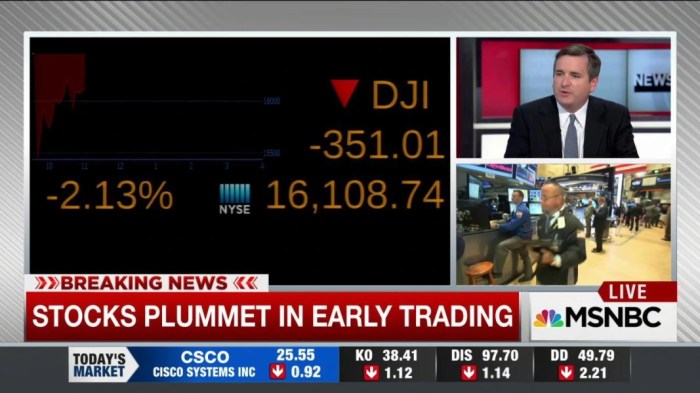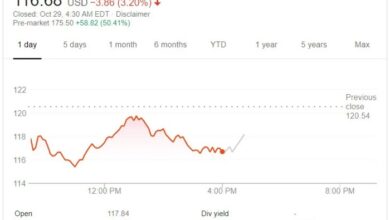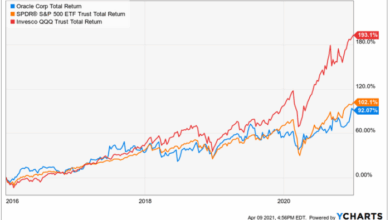
Is the internet stock party over? The frenzy of online stock speculation, fueled by social media and rapid gains, seems to be waning. This article delves into the factors that contributed to this phenomenon, from its origins to its possible decline. We’ll examine investor psychology, potential long-term implications, and whether regulatory responses are keeping up with these ever-changing market trends.
The “internet stock party” was characterized by a unique blend of online investment, social media hype, and often, significant volatility. Historical examples and recent trends will be examined to provide a comprehensive understanding of this phenomenon, contrasting it with traditional stock market investments.
Defining the “Internet Stock Party”
The “Internet Stock Party,” a recent phenomenon, refers to a period of heightened speculative activity in the stock market, predominantly fueled by social media and online communities. Characterized by rapid price swings, often driven by hype and narratives rather than fundamental analysis, it echoes previous periods of speculative fervor, such as the dot-com bubble or the crypto craze. Today’s version is amplified by the immediacy and reach of online platforms, creating a dynamic environment where information, both accurate and misleading, spreads at lightning speed.The key characteristics that distinguish this phenomenon from other investment trends include the significant role of social media in driving momentum, the often-exaggerated narratives surrounding specific stocks, and the rapid and substantial price fluctuations.
These elements create a self-reinforcing cycle of excitement and speculation, leading to a heightened sense of urgency and risk.Common motivations for participation include the desire to capitalize on rapid gains, the allure of “getting in early” on a potential investment boom, and the social pressure to participate in a perceived “hot” trend. The behavioral aspects often involve a detachment from traditional investment principles, with an emphasis on short-term gains and herd mentality.
Defining Characteristics
The “Internet Stock Party” is marked by distinct characteristics that differentiate it from traditional investment practices. These include:
- Social Media Amplification: Online communities and social media platforms play a crucial role in disseminating information and creating momentum. This rapid dissemination of often-unverified or exaggerated information can fuel rapid price swings.
- Narrative-Driven Speculation: The phenomenon is frequently driven by narratives and stories about a company’s potential, often independent of its actual financial performance. This can lead to significant price discrepancies.
- Short-Term Focus: Participants are often more concerned with short-term gains and rapid price increases than with long-term investment prospects.
Motivations and Behaviors
Understanding the motivations and behaviors associated with participation in these parties is crucial to assessing the risks involved. Participants are often drawn to the potential for quick profits, the excitement of being part of a trend, and the perceived opportunity to “get in on the ground floor” of a potentially lucrative investment.
- The Desire for Quick Profits: The potential for substantial and rapid gains is a primary driver. The speed of price changes, amplified by social media, fuels this desire.
- Social Pressure and Herd Mentality: The pervasive nature of online communities and the visibility of others’ successes can create social pressure to participate. This often leads to investment decisions based on the perceived actions of others rather than individual analysis.
- Misinformation and FOMO (Fear of Missing Out): The rapid spread of information online, often unverified, can lead to misinformation and exacerbate FOMO, pushing participants to make impulsive decisions.
Comparison with Traditional Investment
A table illustrating the key differences between the “Internet Stock Party” and traditional stock market investment provides a clear contrast.
| Characteristic | Internet Stock Party | Traditional Stock Market Investment |
|---|---|---|
| Driving Force | Social media hype, narratives, and short-term gains | Fundamental analysis, company performance, long-term prospects |
| Information Source | Unverified online sources, social media trends | Financial reports, company news, analyst opinions |
| Investment Horizon | Short-term, focused on quick gains | Long-term, focused on consistent growth |
| Risk Tolerance | Higher risk tolerance, often driven by speculative motivations | Lower risk tolerance, often based on thorough due diligence |
| Behavioral Patterns | Herd mentality, impulsive decisions, emotional trading | Disciplined approach, rational decision-making, risk management |
Factors Contributing to the Rise and Fall
The “Internet Stock Party,” a period of frenzied speculation and rapid growth in internet-based companies, captivated the public imagination. Understanding its rise and fall requires examining the forces that propelled it and the factors that ultimately led to its decline. This examination will delve into the key drivers, from social media’s role to regulatory shifts.The rapid ascent of the internet stock market was fueled by a potent cocktail of factors.
Excitement over the potential of the internet’s transformative power, combined with easy access to investment platforms, created a fertile ground for speculation. This was further amplified by a sense of opportunity and a belief in the boundless potential of online businesses.
Primary Factors Fueling the Rise, Is the internet stock party over
Initial enthusiasm for internet stocks stemmed from a profound belief in the transformative power of the internet. This was coupled with the ease of accessing investment platforms, making it possible for individuals with limited experience to participate. The rapid growth of e-commerce and the rise of online communities amplified this enthusiasm. Furthermore, early internet successes and a perceived low-risk environment contributed to the prevailing optimism.
Elements Contributing to the Recent Decline
Several factors contributed to the recent decline of the internet stock market. The initial euphoria gave way to concerns about valuation, sustainability, and profitability. Subsequent market corrections and the exposure of inflated valuations played a significant role. Increased scrutiny from regulators and the emergence of more realistic expectations further dampened the enthusiasm. Finally, the broader economic climate, including inflation and rising interest rates, influenced investor sentiment and led to a pullback.
Role of Social Media and Online Communities
Social media and online communities played a crucial role in shaping the internet stock party. These platforms facilitated the rapid dissemination of information, both accurate and inaccurate, fueling speculation and influencing investor decisions. The amplification effect of social media could rapidly propel stock prices upward, but also create sudden and dramatic drops. The dynamic nature of online communities meant that opinions and narratives shifted rapidly, often influencing the market sentiment.
Impact of Regulatory Changes
Regulatory changes have had a complex and multifaceted impact on the internet stock party. Initially, there was a relative lack of regulatory oversight, fostering a climate ripe for speculation. However, as concerns about investor protection and market stability emerged, regulators responded with increased scrutiny and new rules.
| Regulatory Change | Impact on Internet Stock Party |
|---|---|
| Increased scrutiny by SEC | Caused a reassessment of valuations and profitability, leading to investor caution. |
| New regulations on online brokerages | Enforced greater transparency and accountability, potentially impacting the ease of access for retail investors. |
| Changes in market regulations | Affected investor sentiment and influenced market behaviour. |
Analyzing Investor Psychology

The “internet stock party,” a period of frenzied investment in internet-related companies, wasn’t just about market trends; it was a fascinating study in human behavior. Understanding the psychology behind these investment decisions is crucial to grasping the rise and fall of these speculative bubbles and recognizing potential patterns in future market fluctuations. Investors, driven by a complex interplay of emotions and social dynamics, often deviate from rational decision-making.Investor psychology plays a critical role in shaping market behavior during periods of rapid growth and subsequent decline.
Understanding these psychological factors can help investors make more informed decisions, mitigate risks, and avoid the pitfalls of emotional investment strategies. The internet stock party exemplifies the powerful influence of collective psychology on market movements, highlighting the importance of recognizing and managing individual biases and groupthink.
Common Psychological Traits and Behaviors
Investors often display a combination of optimism, fear, and herd mentality. The initial excitement and anticipation of rapid returns often mask underlying risks and uncertainties. A belief in the inevitable success of the industry can lead to excessive investment, even when fundamental analysis suggests otherwise. This optimism, coupled with a desire to capitalize on the perceived potential, can fuel speculative bubbles, where prices become detached from intrinsic value.
This is further compounded by a fear of missing out (FOMO), which drives investors to participate in the excitement, even if they lack a complete understanding of the investment.
Speculative Bubbles and Market Volatility
Speculative bubbles, characterized by an unsustainable increase in asset prices, are a common feature of market cycles. These bubbles are often driven by a combination of factors, including investor psychology, market sentiment, and social dynamics. The internet stock party illustrates how these factors can lead to significant market volatility. Prices can surge dramatically in a short period, creating an environment where investors chase returns without considering the underlying risks.
A prime example is the dot-com bubble of the late 1990s, where many companies, despite having little to no revenue or profitability, saw their stock prices soar based on speculative hype. This ultimately led to a sharp correction and a substantial loss for many investors.
Influence of Social Proof and Herd Mentality
Social proof and herd mentality significantly influence investor decisions during periods of high market volatility. Investors are often influenced by the actions and opinions of others. Positive news or the actions of prominent investors can trigger a wave of investment, pushing prices higher. Conversely, negative news or a sudden sell-off can trigger a panic, leading to a rapid decline in prices.
This phenomenon can create a self-reinforcing cycle, amplifying both gains and losses. Social media and online forums play a crucial role in disseminating information and influencing collective behavior, amplifying the effects of social proof and herd mentality.
Role of Emotions in Investment Decisions
Emotions such as greed, fear, and excitement can significantly impact investment decisions. Greed can lead investors to overestimate potential returns and underestimate risks. Fear can cause investors to panic and sell assets at low prices, exacerbating market downturns. Excitement and enthusiasm, fueled by the perceived potential of a new industry, can cloud judgment and lead to irrational investment choices.
It’s crucial to acknowledge these emotional responses and develop strategies to manage them effectively.
Rational vs. Emotional Investment Decisions
| Characteristic | Rational Investment Decision | Emotional Investment Decision |
|---|---|---|
| Motivation | Long-term financial goals, thorough research | Fear of missing out, hype, greed |
| Analysis | Fundamental and technical analysis, assessment of risk | Limited or biased analysis, influenced by market sentiment |
| Decision-making | Based on facts, objective evaluation | Impulsive, based on feelings and emotions |
| Risk Tolerance | Controlled, managed based on risk assessment | Often overestimated, influenced by market sentiment |
| Flexibility | Adaptable to changing market conditions | Resistant to changing conditions, often inflexible |
Long-Term Implications and Future Trends
The recent “internet stock party,” characterized by rapid price increases and frenzied trading, raises critical questions about the long-term health of the market and investor behavior. Understanding the potential implications is crucial for navigating future market volatility and adapting investment strategies. This period highlights the need for a more nuanced approach to assessing risk and understanding the factors that drive speculative bubbles.The speculative nature of the internet stock party, coupled with the ease of access to online trading platforms, underscores the potential for similar events in the future.
This volatility, while potentially creating opportunities for some, also presents considerable risks for others. A crucial element of this analysis is understanding how these trends might influence future investment strategies and regulatory responses.
Potential Long-Term Implications for the Stock Market
The internet stock party has demonstrated the significant impact of social media and online communities on market sentiment. These trends can amplify both positive and negative market reactions, creating periods of extreme volatility. The rapid rise and fall of certain stocks can have ripple effects across various sectors, impacting broader economic indicators.
How the Phenomenon Might Influence Future Investment Strategies
Investors are likely to become more cautious and discerning in their investment decisions. The lesson learned from the internet stock party is that relying solely on social trends or hype is often detrimental. A more analytical and fact-based approach to valuation and risk assessment is likely to gain traction. Diversification across asset classes and a greater emphasis on fundamental analysis may become more prominent investment strategies.
Possible Regulatory Responses to Future “Internet Stock Parties”
Governments and regulatory bodies might consider introducing new regulations to mitigate the risks associated with excessive speculation. This could include measures to curb the spread of misinformation and manipulate market trends online. For instance, stricter requirements for market participants or new guidelines for social media platforms to prevent the propagation of false information are potential responses. International cooperation in regulating these aspects of online investment is also likely to be a consideration.
Potential Changes in Investor Behavior and Market Dynamics
The “internet stock party” may lead to a shift in investor demographics. Younger generations, more accustomed to online interactions and trading platforms, may be more likely to participate in future speculative bubbles. However, increased awareness and education about the risks associated with speculative investment are also expected to impact future investor behavior. A more diverse range of investor behaviors, including those more wary of speculation, may emerge as a consequence of the recent events.
Potential Scenarios for the Future of Internet-Based Investment Trends
| Scenario | Description | Potential Impact |
|---|---|---|
| Increased Regulation | Governments implement stricter regulations on online trading platforms and social media platforms to curb the spread of misinformation. | Reduced market volatility, but potentially slower growth in online investment. |
| Greater Investor Sophistication | Investors become more discerning and critical of investment advice and market trends, relying on more fundamental analysis. | Reduced speculative bubbles, but potentially reduced market liquidity. |
| Rise of Algorithmic Trading | Automated trading systems play a more significant role in market activity, potentially leading to increased volatility and rapid price fluctuations. | Greater market efficiency but also increased potential for unexpected price swings. |
| Continued Social Media Influence | Social media continues to drive market sentiment and investment decisions, although with a greater awareness of potential risks. | Continued volatility, but with a greater emphasis on fact-based analysis and informed investment decisions. |
Case Studies and Examples
The “internet stock party,” fueled by optimism and speculation, has left a trail of memorable, and often cautionary, examples. Understanding these past events can illuminate potential pitfalls and provide valuable insights for navigating future market trends. Analyzing the trajectory of these events, from initial hype to eventual decline, allows investors to develop a more nuanced understanding of market psychology and the inherent risks associated with speculative bubbles.These examples demonstrate that periods of rapid growth, driven by exuberance and expectations of extraordinary returns, often end abruptly.
The key is to learn from these experiences, focusing on fundamental analysis and risk management strategies. Identifying the common threads in these past episodes can help investors make more informed decisions and avoid repeating past mistakes.
Notable Internet Stock Party Instances
The dot-com boom of the late 1990s and early 2000s provides a powerful illustration of the “internet stock party” phenomenon. Characterized by an explosive rise in internet-related company valuations, this period saw significant speculation and substantial wealth creation for some, while others suffered significant losses.
So, is the internet stock party over? Maybe. A lot of the hype is definitely fading, but there’s still a lot of movement in the market. Plus, with things like playboy fights for you , the focus is shifting. It’s not just about the quick buck anymore, and that’s likely going to change how the market operates in the long run.
Perhaps the internet stock party is morphing into something else entirely, but it’s definitely not dead.
Specific Examples of Companies and Stocks
Numerous companies were caught up in the frenzy. A prime example is Pets.com, a company that promised to revolutionize online pet supplies. Its stock price soared on the promise of a vibrant online market for pet products, only to crash spectacularly as the company struggled to maintain profitability and execute its business plan. Similarly, Webvan, a grocery delivery service, also experienced a rapid rise and fall, highlighting the difficulty of navigating the complexities of the new digital marketplace.
These examples illustrate the danger of chasing hype rather than sound fundamentals.
Outcomes and Lessons Learned
The outcome of these internet stock parties often involved significant financial losses for investors who chased the hype. The speculative nature of these investments meant that companies were often valued far beyond their actual worth, creating an unsustainable bubble. Lessons learned include the importance of conducting thorough due diligence, understanding the fundamental viability of a company, and not letting emotions dictate investment decisions.
Recognizing and mitigating risk are crucial to navigating speculative markets.
Typical Trajectory of Events
The typical trajectory often starts with initial excitement and rapid price appreciation. This period is usually characterized by strong investor sentiment, media hype, and a belief that the growth is unstoppable. However, as reality sets in, the bubble begins to deflate, often rapidly. This decline can be driven by factors like declining sales, lack of profitability, or a shift in investor sentiment.
This rapid decline can lead to substantial losses for those who invested during the peak.
Using Examples to Inform Future Investment Decisions
The internet stock party case studies provide a cautionary tale. By examining the specific characteristics of these events, investors can develop a better understanding of market psychology and the importance of fundamental analysis. A crucial lesson is that speculative bubbles are often unsustainable and can lead to significant losses. Evaluating companies based on their intrinsic value, understanding market dynamics, and carefully assessing risks are critical for making sound investment decisions.
This knowledge helps investors avoid repeating the mistakes of the past and navigate the complexities of the market more effectively.
Alternative Investment Strategies
The internet stock party’s dramatic rise and fall highlights the dangers of chasing speculative bubbles. Investors now need to consider alternative investment strategies to build more diversified and resilient portfolios. These strategies offer avenues for growth beyond the often-volatile tech sector, providing a wider range of potential returns and risk profiles.Alternative investments, by their very nature, differ from the traditional stocks and bonds approach.
They often involve illiquidity, meaning that accessing your funds can take longer than with readily traded securities. However, they can potentially generate higher returns and offer diversification benefits, mitigating the risk of concentrated investments.
Real Estate Investment Trusts (REITs)
REITs allow investors to participate in the real estate market without directly owning properties. They pool capital from many investors and invest in income-generating real estate, such as apartments, offices, or retail spaces. REITs often offer relatively stable income streams through dividends, making them a potentially attractive alternative for those seeking passive income. However, REITs can be susceptible to economic downturns, especially in sectors like retail, which saw significant shifts during the pandemic.
Their performance can be correlated with broader economic trends, affecting their potential returns.
Private Equity
Private equity involves investing in privately held companies that are not publicly traded. This often entails a higher degree of risk compared to publicly traded equities but can offer potentially higher returns if the investment proves successful. The investment timeframe can be significantly longer than with public stocks. There’s also less transparency in valuations, making due diligence more critical.
Diversifying into private equity can offer a unique investment opportunity, but investors should carefully assess the potential risks and long-term implications.
Commodities
Commodities, such as gold, oil, or agricultural products, represent another alternative investment strategy. They often serve as a hedge against inflation or economic uncertainty, with prices potentially moving in different directions from stocks and bonds. Commodities can be a valuable component of a diversified portfolio, but their price volatility needs to be considered. For example, fluctuating oil prices can significantly impact investment returns.
Is the internet stock party finally over? Maybe not quite yet, but the recent news of Yahoo boosting small business commerce offerings, like yahoo boosts small bize commerce offerings , suggests a shift in the market. It might signal a more sustainable, less speculative, focus on practical e-commerce solutions, rather than just the next big hype. This could mean a more measured, and possibly more lucrative, approach for everyone involved, potentially changing the whole game for the future of internet commerce.
Hedge Funds
Hedge funds employ sophisticated investment strategies, often involving complex trading techniques and alternative asset classes. They aim to generate high returns, sometimes exceeding those of traditional investments, but come with a significantly higher price tag and a higher risk profile. Hedge funds are not accessible to all investors and require careful research and due diligence.
So, is the internet stock party over? Maybe not quite yet. While the hype train might be slowing down, Goldman Sachs’ recent investment in Wit Capital, a company focused on AI-powered financial services, suggests some serious players still see potential in the sector. Goldman Sachs invests in wit capital could be a sign that the industry is evolving, not disappearing.
It’s definitely a fascinating time to be observing the market and wondering if this is just a pause or a longer, cooler phase for internet stocks.
Infrastructure Investments
Infrastructure investments involve funding projects like roads, bridges, or public transportation. They offer the potential for stable returns through long-term contracts and government support. However, project timelines and regulatory hurdles can impact returns. The long-term nature of these investments needs to be considered carefully. Understanding the political and economic environment of the region can also affect potential returns.
Diversification
A crucial aspect of any investment strategy is diversification. Diversification across different asset classes, including stocks, bonds, and alternative investments, can help mitigate risk and enhance potential returns. The “internet stock party” approach, heavily focused on a single sector, exemplifies the dangers of concentrated investments. A diversified portfolio can help absorb shocks in specific markets or sectors.
A balanced portfolio can withstand market volatility and improve long-term investment performance.
Illustrative Examples of Market Trends

The “internet stock party” phenomenon, marked by rapid growth and speculation in internet-related companies, isn’t a singular event but rather a recurring pattern with identifiable historical and contemporary echoes. Understanding these trends provides crucial context for evaluating the current market and anticipating future developments. Examining past instances of exuberance and their eventual corrections allows us to better understand the forces driving these cycles.
Historical Market Trend: The Dot-Com Bubble
The late 1990s saw a surge in internet-based companies, many of which were unprofitable or had limited revenue streams. Investors, fueled by optimism about the transformative potential of the internet, bid up stock prices to unsustainable levels. This speculative frenzy, often driven by hype and the belief in “the next big thing,” created a bubble that eventually burst.
Many companies went bankrupt, and investor losses were substantial.The underlying causes included:
- Unrealistic valuations: Companies were often valued based on future potential rather than current performance, leading to inflated stock prices.
- Lack of regulation: The nascent internet market was relatively unregulated, allowing for greater speculation and risk-taking.
- Media hype and investor psychology: Positive media coverage and a pervasive sense of optimism fueled investor enthusiasm and contributed to the unsustainable rise.
This period demonstrates the inherent risk associated with speculative bubbles, highlighting the importance of careful evaluation of company fundamentals and a healthy dose of skepticism when markets are overly exuberant.
Modern Market Trend: The Rise of AI-related Companies
The recent surge in artificial intelligence (AI) stocks mirrors the exuberance of the dot-com era in some ways. Investors are betting on the transformative potential of AI, and numerous companies are being valued based on their hypothetical future impact. This has resulted in substantial increases in the share prices of companies related to AI technology.The underlying causes for this trend include:
- Rapid advancements in AI technology: Continuous innovation and breakthroughs in AI algorithms and applications have fueled investor enthusiasm.
- Increased media coverage and hype: Positive media coverage and popular culture depictions of AI have created a sense of excitement and anticipation.
- Investor confidence in the transformative potential of AI: Investors see AI as a disruptive technology with the potential to revolutionize numerous industries, leading to significant growth.
The connection between this trend and the “internet stock party” is apparent. Both periods feature high valuations of companies with uncertain future performance. The potential for significant returns attracts investors, often overshadowing concerns about current profitability and risk.
Comparison of Market Trends
| Characteristic | Dot-Com Bubble | AI-related Companies |
|---|---|---|
| Driving Force | Internet hype, speculation | AI innovation, media hype |
| Valuation Basis | Future potential, limited revenue | Hypothetical future impact, limited profitability |
| Regulatory Environment | Nascent, largely unregulated | Evolving, with growing scrutiny |
| Investor Psychology | Optimism, exuberance, belief in the “next big thing” | Optimism, excitement, belief in transformative potential |
Conclusive Thoughts: Is The Internet Stock Party Over
In conclusion, the internet stock party, while captivating, appears to be reaching a turning point. While the underlying motivations and behaviors remain, the factors contributing to its rise are now facing significant headwinds. Alternative strategies and investor psychology are critical to understanding the future of online investment. The long-term implications of this phenomenon remain to be seen, but the lessons learned from past experiences could shape future investment decisions and regulatory approaches.





